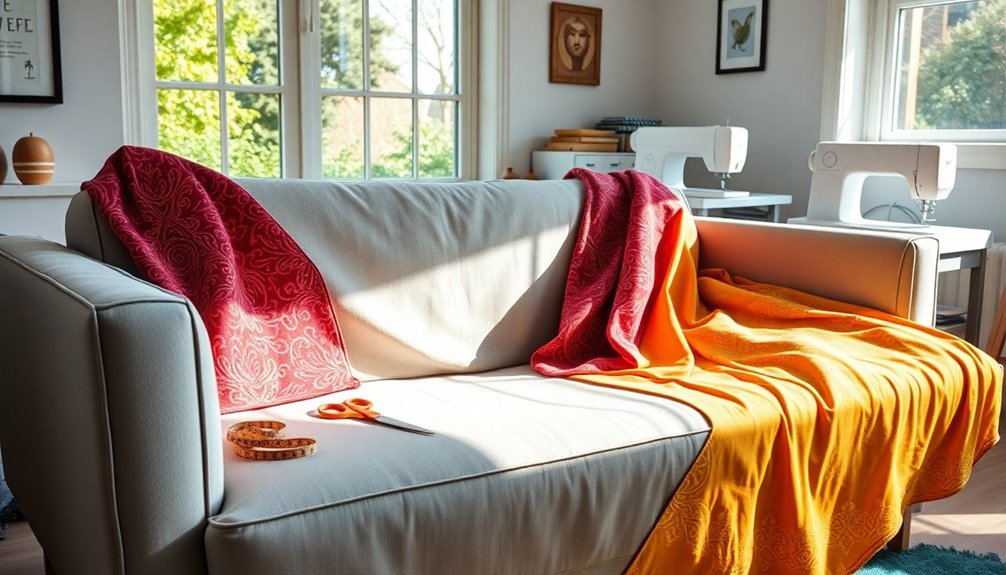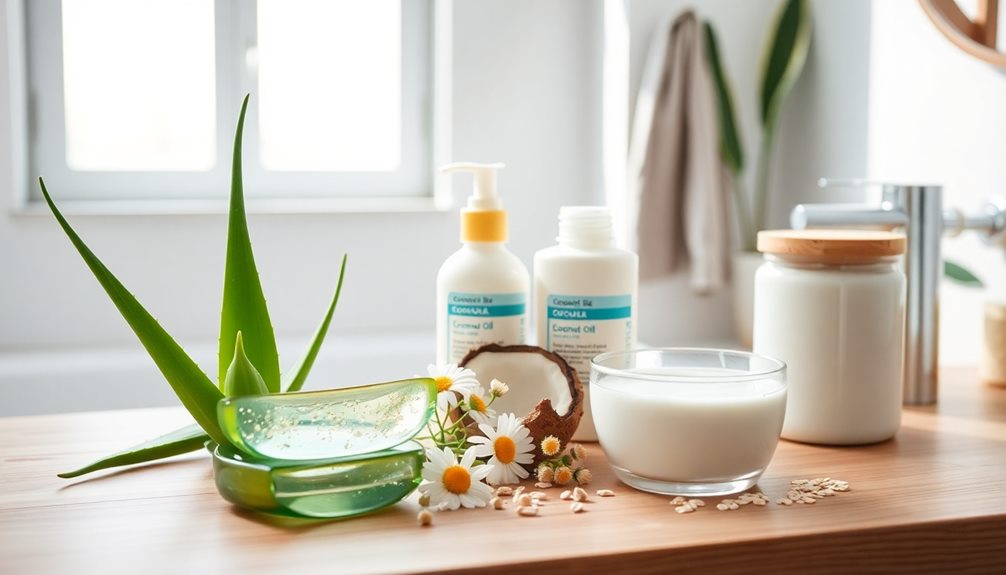Making your own sofa covers is a fun project that can transform your living room. Start by selecting durable fabrics like polyester or canvas and measure your sofa accurately, including arms and cushions. Cut the fabric carefully, ensuring you pin patterns for precision. Then, sew the pieces together, paying attention to seams and corners for a smooth finish. Don't forget to add decorative touches like welting or flanges for flair. Regular maintenance is key, so clean spills promptly and vacuum often. If you want tips on fabric selection and custom designs, there's plenty more to explore.
Key Takeaways
- Measure your sofa accurately, including width, depth, and height, to ensure a proper fit for the covers.
- Choose durable, easy-to-clean fabrics like polyester or canvas, suitable for high-use areas.
- Cut the fabric carefully, following patterns and using precise cutting tools for accuracy.
- Sew the cover sections together, paying attention to seams and ensuring a snug fit on the sofa.
- Maintain the covers by cleaning promptly, vacuuming regularly, and storing them properly to prevent damage.
Materials Needed
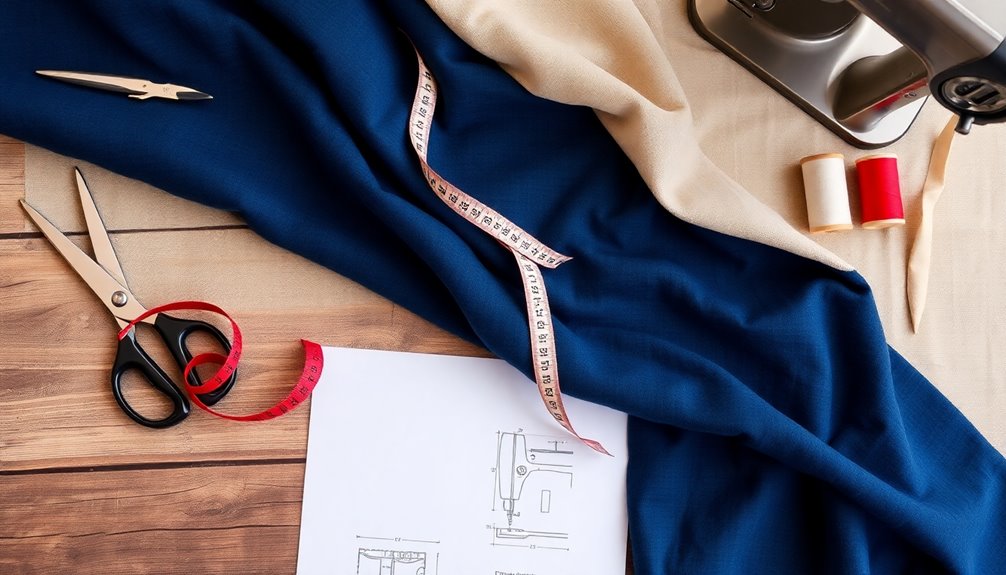
To create your own sofa covers, you'll need a variety of materials that balance durability and aesthetics. Start by choosing fabric that suits your lifestyle. Cotton is great for frequent cleaning but can stain and wrinkle easily. If you want something more durable, polyester is affordable and wrinkle-resistant. Linen dries faster than cotton and resists stains, though it can also wrinkle. Consider blends like polyester-cotton for a balance of durability and fade resistance. A strong brand identity can also guide your choices in fabric by providing insight into what materials are popular and trusted.
For additional options, acrylic offers fade resistance and elasticity, while rayon is inexpensive but often needs dry-cleaning. Velour has a plush feel, and twill provides a unique diagonal pattern. Synthetic suede gives a luxe appearance and is stain-resistant. Using higher-priced polyester-spandex blends can also enhance the overall fit and appearance of your sofa covers.
You'll also need essential sewing supplies: a sewing machine for thicker fabrics, matching thread, and appropriate needles. High-quality scissors will ensure precise cutting, while pins help secure your fabric during sewing. Don't forget tools like canvas fabric or drop cloths for durability, felt for anti-slip purposes, and upholstery zippers for easy cover removal. Continuous learning is important in mastering sewing techniques, which can significantly improve your results. Velcro can assist in securing parts of the slipcover, and a fabric marker will help you mark your fabric accurately.
Measuring the Sofa
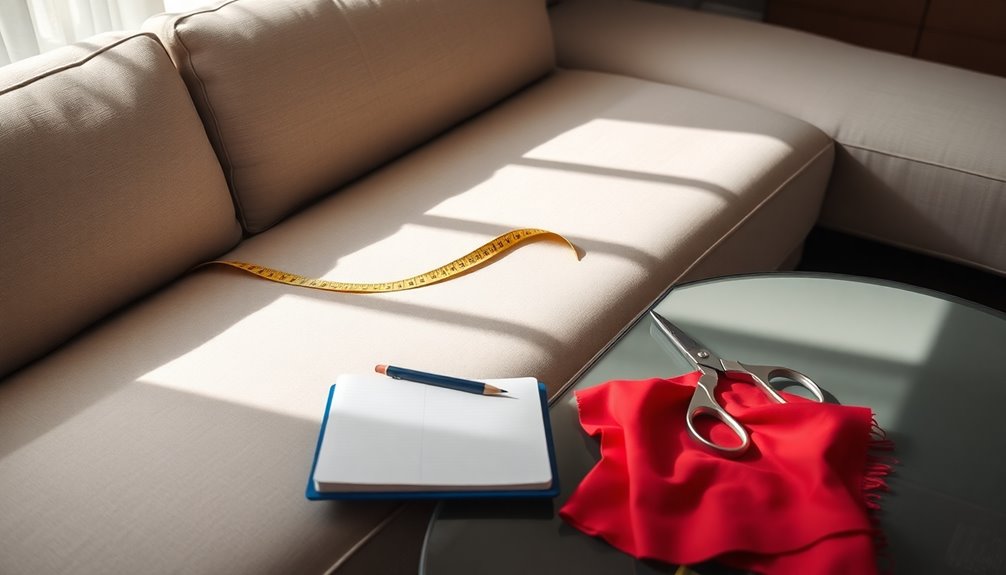
Measuring your sofa accurately is crucial for creating a well-fitting cover. Start by measuring the width, which is the widest side of the sofa. Measure from the outer edge of one arm to the outer edge of the opposite arm, including the width of the armrests. Round up to the nearest inch for accuracy.
Next, measure the depth from the back to the front of the sofa. If your sofa has a curved back, begin at either the top or bottom of the back. Don't forget to measure the seat cushion depth from the front to where it meets the back. If cushions vary in depth, measure each one separately.
Finally, measure the height from the ground to the top of the sofa, accounting for both the armrests and backrest cushions. For a better fit, consider a cover that's 1-2 inches shorter than your sofa. A proper fit ensures protection against wear and tear on your furniture.
Make sure to measure each piece of the sofa independently, including cushions and the frame. Always double-check your measurements to ensure accuracy, and keep a detailed plan with graphics for reference before you start cutting fabric.
Cutting the Fabric
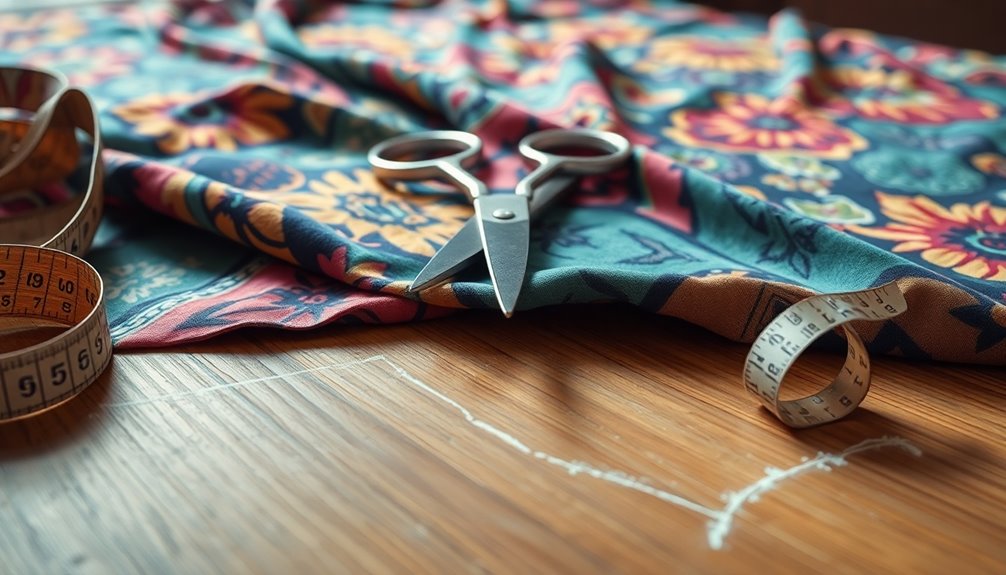
Cutting the fabric accurately is essential for crafting a well-fitted sofa cover. Start by laying your fabric flat on a clean surface. Use a ruler or quilting ruler to guide your cuts, ensuring you keep everything straight. If you're using a rotary cutter, align the ruler along your cutting line. For fabric scissors, mark the cutting line with a fabric marking tool to help you follow it precisely. Keep your scissors steady and the fabric flat for the best results.
When cutting pattern pieces, pin them to your fabric, aligning with the grain. Carefully cut around the patterns, following the marked lines to achieve undistorted cuts. Patience and attention to detail are crucial here. Additionally, using durable fabric is important to ensure the longevity of your slip cover.
For added flexibility, consider bias cutting. This involves cutting at a 45-degree angle to the fabric grain. Fold the fabric so the selvage edges align, then mark your cutting lines. Lastly, before cutting, make sure your fabric is squared. Use a straight edge to mark a straight line, cutting along it for even pieces. If you need multiple identical pieces, stack and pin the layers to save time and ensure consistency.
Sewing the Cover
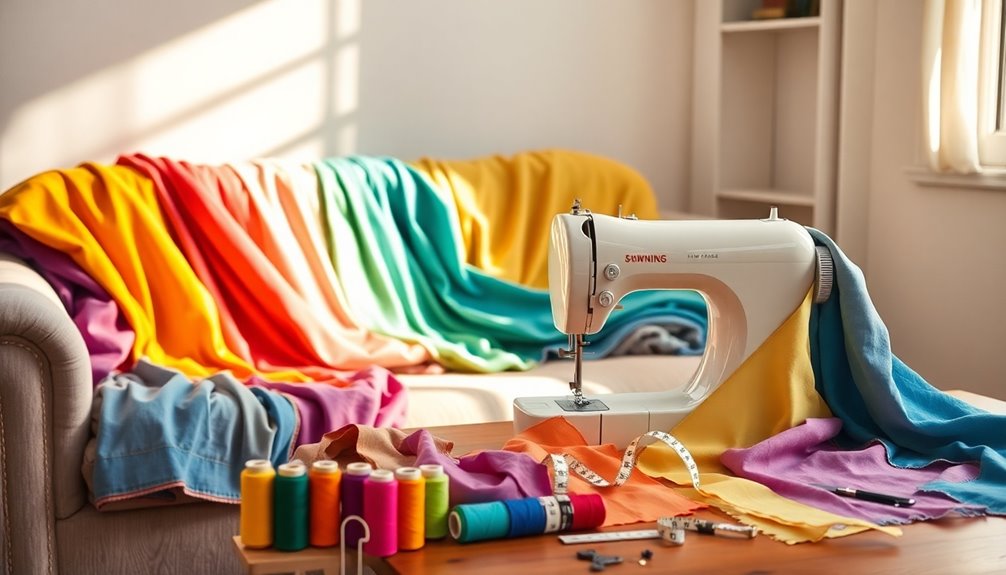
Once you've prepared and pinned your fabric, it's time to start sewing the cover. Begin with the more challenging seams, like the inside arm to the inside back. Use clips to navigate the curves and ensure a smooth fit. Once that's done, sew the inside arm to the outside arm, paying special attention to the straight seam underneath.
Next, tackle the inside back where it meets the deck, creating a strong seam. Follow up by attaching the inside arm to the deck, then connect the arm fronts to both the inside and outside arms. Finally, sew the outside back seam, which intertwines with other seams around the sofa's body. Order of seams is crucial to ensure proper assembly and stability throughout the process.
For corners and intersections, roll the fabric between your fingers to avoid gathers, and pin securely. Use plenty of pins at three-way intersections and make adjustments as needed for a snug fit. Make sure to press folds down on either side of the seams to even out the thickness.
Throughout this process, utilize a cording foot for most seams, switching to a zipper foot when needed. This attention to detail will ensure a polished and professional-looking sofa cover.
Adding Finishing Touches
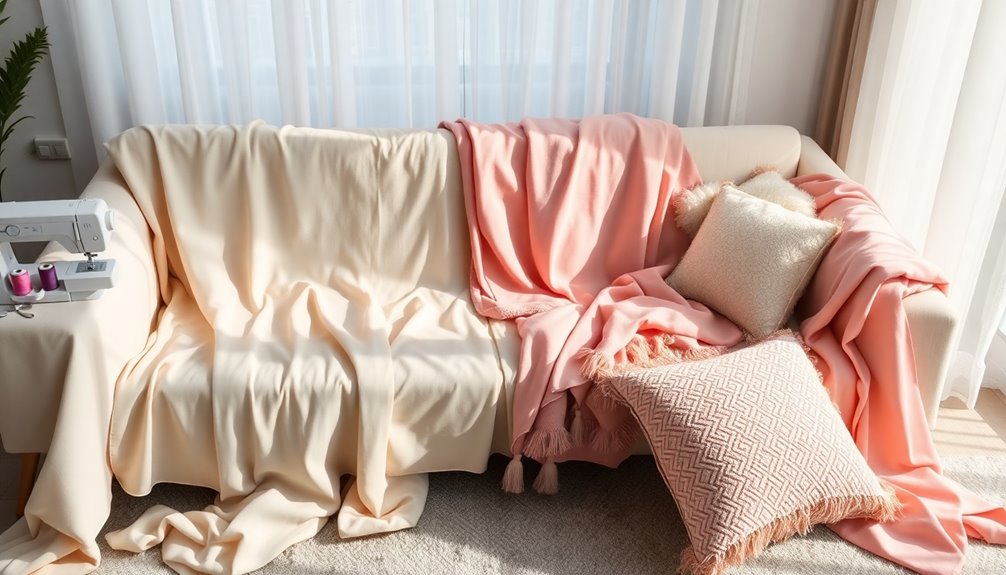
With the seams securely stitched, you can now focus on adding the finishing touches that will elevate your sofa cover. Start by incorporating decorative finishes like welt cord or a stylish flange along the edges. These details give your slipcover a polished look. Consider adding topstitching for an aesthetic boost, or use contrasting threads to create a striking visual effect.
For functional finishes, reinforce your seams with an overlock or zigzag stitch to prevent fraying. If you're using zippers, make sure they're securely attached to avoid any mishaps. You can also wrap raw edges with stitches to enhance durability. Additionally, choosing the right fabric will ensure that your cover is both stylish and practical, as it should be machine washable to make cleaning easy, especially if you have pets.
Finally, think about styling. Tuck and smooth the fabric for a neat finish, aligning it around cushions properly. To complete the look, add some throw pillows that complement your color scheme and match the overall décor of your space. These finishing touches will transform your sofa cover into a beautiful centerpiece in your home.
Fitting and Adjusting
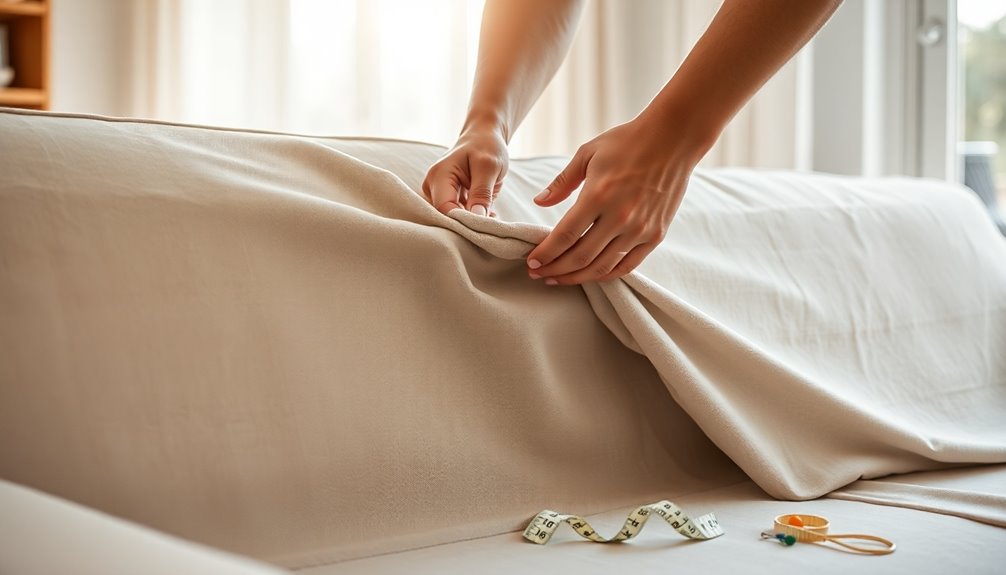
Preparing your sofa for the slipcover is crucial for achieving a smooth and polished fit. Start by removing any pillows or cushions, which allows for easier installation. Align the loose pillows along the back to create a uniform surface, and fill any gaps with quilt batting for a smooth back. Accurately measure your sofa's dimensions, noting any unique features like T-cushions or lower seat heights, so you can adjust the slipcover accordingly.
Next, pull the slipcover over the sofa with the tag positioned at the back middle. Stretch the fabric from the back to the front and across both armrests, ensuring full coverage. Tuck excess fabric into the creases, using foam rollers if needed to smooth out wrinkles. Secure the slipcover with elastic strips, ties, or clips, especially between the back and seat cushions. You may need to adjust and smooth out the slipcover several times to achieve a neat and seamless appearance. Once the slipcover is in place, take a moment to ensure that the sofa bed mechanism is working properly. Check for any loose or damaged parts, and make any necessary adjustments, especially if the sofa bed has not been used in a while. Fixing sofa bed mechanism may require some additional tools or expertise, so don’t hesitate to seek professional assistance if needed. With the slipcover secured and the sofa bed mechanism in good working order, your sofa will be both stylish and functional.
For two-piece sectionals, apply covers separately before reassembling. To maintain a snug fit, regularly check and adjust the slipcover after use. Tighten all ties and clips, and consider economical solutions if necessary. Keep smoothing out wrinkles and re-tucking fabric to ensure your slipcover looks neat and well-fitted.
Tips for Choosing Fabric
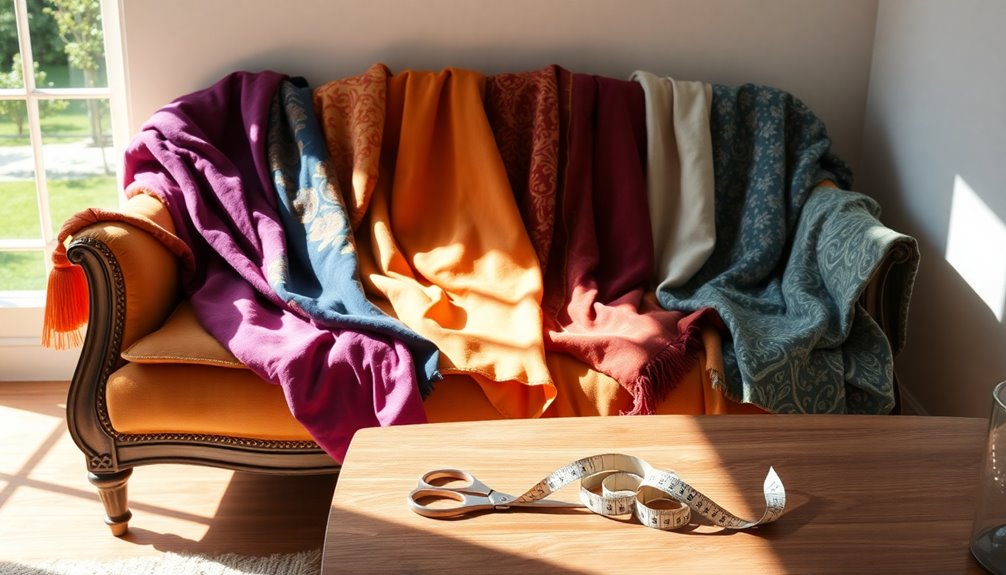
Choosing the right fabric for your sofa cover can make all the difference in both style and functionality. Start by considering durability; polyester and canvas are great choices for high-use areas, as they resist stains and wrinkles. If you want something breathable and comfortable, cotton is fantastic, but keep in mind it may require more maintenance due to its absorbency. Cotton is also known for its resistance to fading, making it suitable for sunny locations.
Think about the feel of the fabric, too. Chenille and velvet offer a luxurious touch, while cotton and linen provide natural comfort. Blends like twill can give you the best of both worlds: durability and softness.
When it comes to style, you'll find cotton is highly versatile, readily taking on patterns and colors. Linen adds an elegant touch, while velvet can elevate your space with its richness.
Finally, consider care and maintenance. Opt for machine-washable fabrics like cotton, twill, and canvas for easy cleaning. Remember to buy extra fabric to account for potential shrinkage. By balancing durability, comfort, and style, you'll choose the perfect fabric for your sofa cover.
Maintaining Your Sofa Covers
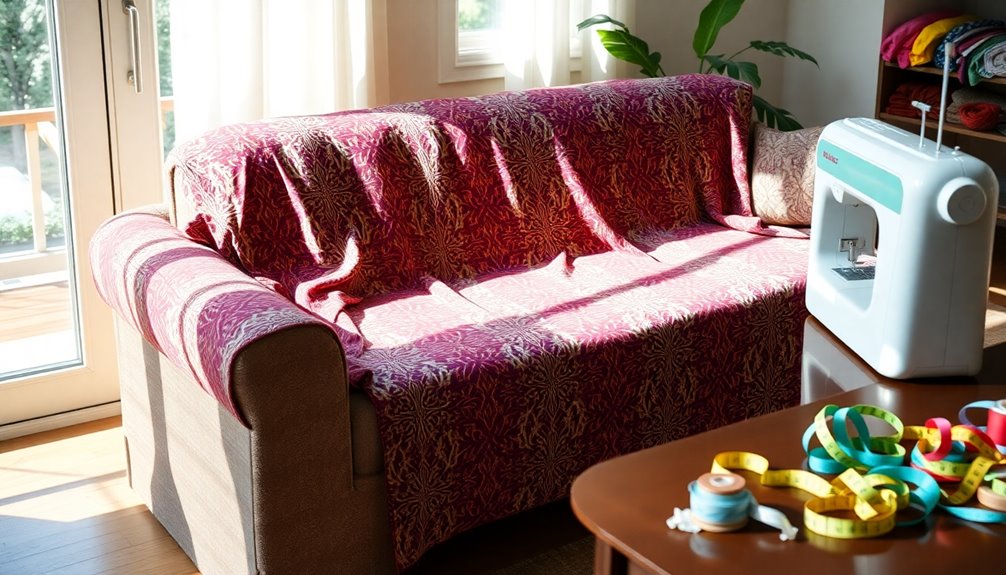
Once you've selected the perfect fabric for your sofa cover, maintaining it becomes key to keeping your furniture looking fresh and stylish. Start by cleaning and removing stains promptly. Use a damp cloth with a mild cleaner to tackle spills, and always blot immediately to prevent stains from setting. For stubborn stains, pretreat with a stain remover before washing, and remember to test any cleaning solution on a hidden area first.
Vacuum your sofa cover regularly to eliminate dust, crumbs, and pet hair. A soft brush attachment works wonders for gently removing debris from the surface and crevices. This simple step helps prevent dirt accumulation that could lead to unwanted stains. Regular vacuuming also maintains appearance and hygiene of the cover.
When it's time to wash your cover, hang it to air dry or tumble dry on low heat. Avoid high heat, as it can shrink or damage the fabric. If ironing is necessary, use a low heat setting, or consider steam ironing for delicate fabrics like velvet.
Lastly, store your sofa cover in a breathable bag to prevent moisture buildup and protect it from direct sunlight to avoid fading. These steps will ensure your sofa covers remain in excellent condition for years to come.
Customizing for Unique Designs
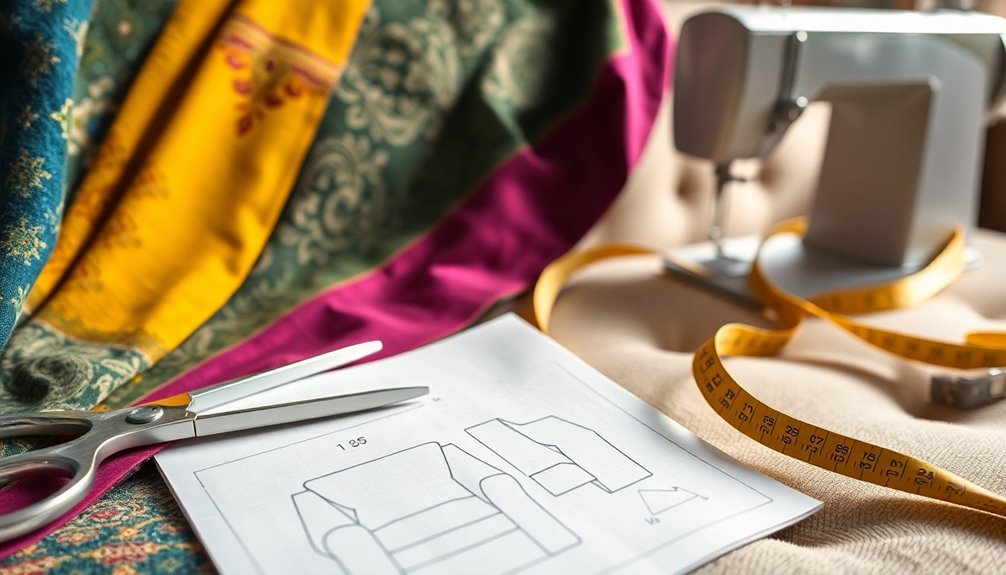
When it comes to customizing your sofa covers, the right approach can transform your space and highlight your personal style. Start by measuring your sofa and cushions accurately. Remove existing covers and measure the cushions inside out to get precise dimensions. Create technical drawings or digital outlines to help with fabric calculations.
Next, choose your fabric wisely. You can select from various materials like linens, cottons, synthetics, velvets, and leathers. Consider designing custom patterns using tools like Photoshop, and think about collaborating with fabric printing services for unique designs. Don't forget to pick fabrics with properties that suit your lifestyle, such as spill-resistant or machine-washable options. Additionally, consider using custom slipcovers to ensure a perfect fit for your specific sofa model.
For added flair, incorporate customizations such as contrast piping, pleated skirts, or even side pockets. Separate seat cushion covers can give you a tailored fit, while different finishes and textures can enhance the overall aesthetic. By thoughtfully planning these elements, you'll ensure that your slipcover design reflects your unique style and meets the needs of your space. With the right fabric and personalized touches, your sofa will become a stunning focal point in your home.
Troubleshooting Common Issues
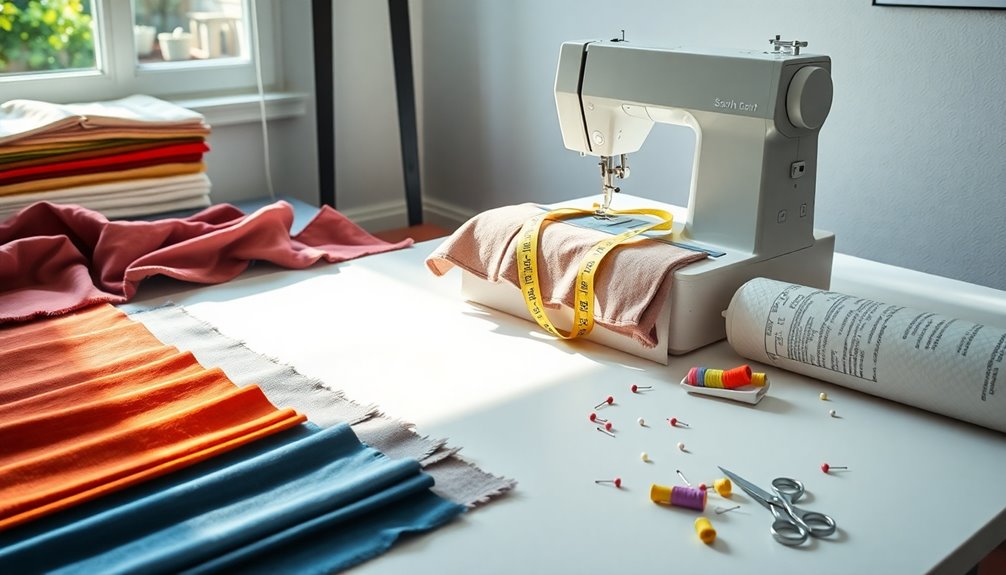
Troubleshooting common issues with sofa covers is essential for maintaining their appearance and longevity. Start by identifying the fabric type before washing; not all fabrics are machine washable, so always check the care label for specific instructions. For delicate fabrics like silk or wool, consider professional cleaning to avoid damage.
Before washing, inspect your covers for loose threads or small tears and repair any damages to prevent further deterioration. Use a mild detergent with cold water, and avoid bleach to minimize the risk of discoloration. Washing different colored covers together can lead to unwanted color bleeding, so keep them separate. Additionally, following the care instructions on the label is crucial for preserving the fabric's integrity.
When it comes to drying, skip the hot dryer; high heat can cause shrinkage and fading. Opt for air drying or a low-heat setting instead. Be mindful that natural fibers like cotton are more prone to shrinkage, while polyester and synthetic fabrics are generally more resilient.
For stains, pre-treat using a gentle, fabric-safe stain remover. Regular maintenance will help prevent pilling on synthetic fabrics, and avoid strong detergents that can lead to color fading and fabric breakage. By following these tips, you'll keep your sofa covers looking great for years to come.
Frequently Asked Questions
What Types of Fabric Are Best for Sofa Covers?
When choosing fabric for sofa covers, consider durability, comfort, and maintenance. Twill and canvas are great for high-traffic areas, while polyester offers easy cleaning. For a soft touch, chenille works well, combining comfort and durability. If you want breathability, cotton and linen are solid choices, though they may stain. Remember to prioritize tightly woven textiles for better wear and tear, ensuring your sofa covers stay looking fresh and inviting for longer.
Can I Use a Sewing Machine for Upholstery Fabric?
Yes, you can use a sewing machine for upholstery fabric, but it's crucial to choose the right machine. Regular machines might struggle with heavy materials and could break needles or damage the motor. Opt for a heavy-duty machine or one with a walking foot attachment to handle thicker fabrics. Make sure to use heavy-duty needles and strong upholstery thread to ensure your project withstands wear and tear effectively.
How Do I Clean My Sofa Covers After Making Them?
To clean your sofa covers, start by vacuuming them to remove dirt and pet hair. Check the care label for washing instructions, then either machine wash on a cold, delicate cycle with dye-free detergent or hand wash in mild soapy water. Avoid bleach and fabric softeners. After washing, hang or line dry to prevent heat damage, and put the covers back on while they're still damp to minimize wrinkles.
What Is the Best Way to Store Sofa Covers When Not in Use?
To store your sofa covers when not in use, first ensure they're completely clean and dry. Fold them neatly, squaring up all edges, and consider using a waterproof container if you're in a damp area. Avoid tight plastic wraps; they can trap moisture. Instead, use fabric covers or breathable bags. Label your storage solution for easy identification, and keep them in a dry spot to prevent damage from moisture or pests.
Can I Alter the Cover After It's Been Sewn?
Yes, you can definitely alter the cover after it's been sewn. Start by evaluating the fit and deciding what adjustments you need. Use a tape measure to identify areas that require modification. You can trim excess fabric, re-pin, and re-sew seams for a better fit. If you're dealing with cushion covers, add pins along curved edges for support. Just remember to check the fit frequently to ensure your adjustments are effective.
Conclusion
By following these steps, you can create beautiful, custom sofa covers that not only protect your furniture but also enhance your home's decor. Remember to choose the right fabric, measure accurately, and add those finishing touches to make your covers truly unique. With a little creativity and effort, you'll transform your sofa into a stylish centerpiece. Don't forget to maintain your covers for lasting beauty and comfort. Enjoy your new look and the satisfaction of DIY craftsmanship!
